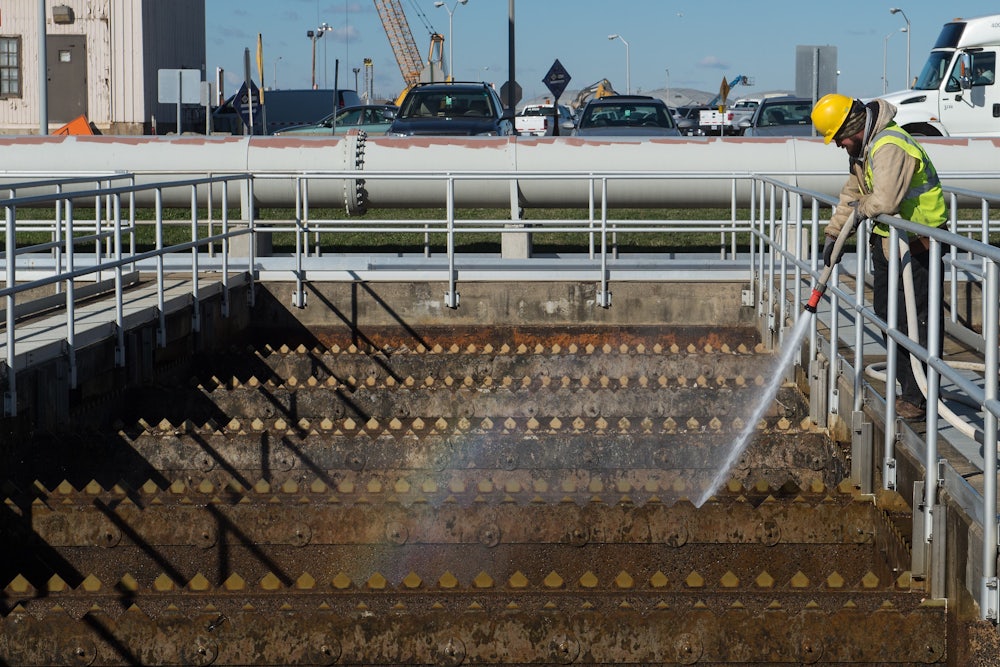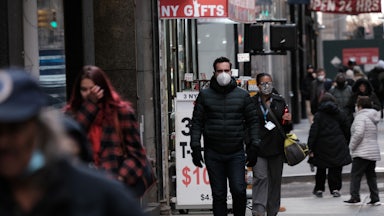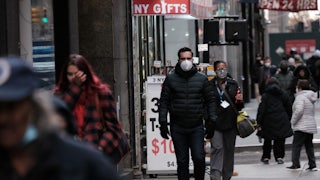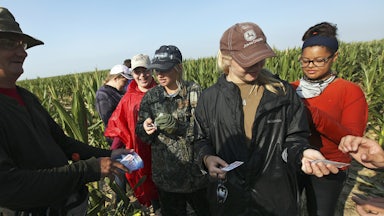Not everyone will get a Covid test, but everyone poops. That’s why cities across the United States are using municipal wastewater to track the still-raging pandemic. The amount of the SARS CoV-2 RNA in the sewershed can indicate the level of the virus in a community as a whole, whether or not individuals above ground are experiencing symptoms. In fact, the tool is a leading indicator of Covid-19’s spread, predicting spikes three to seven days before the number of reported cases rises. It’s also drawn public attention to the sewer system’s vast public health potential—and just how much managing wastewater will matter in the face of accelerating climate change. (After this piece was published, the CDC launched a new dashboard to display data from the National Wastewater Surveillance System. White House Covid-19 Data Director Cyrus Shahpar tweeted that “plans are to expand this to cover all 50 states.”)*
In the past week alone, local wastewater data has shown that infection rates have finally begun to slow in many parts of the country, from St. Louis to Boston; conversely, some communities, like San Rafael, California, may soon see a spike in cases. Earlier in the pandemic, scientists used wastewater to identify mutations in the virus. In the most recent wave, they’ve also used it to show that overall omicron-variant case counts have been dramatically underestimated. Wastewater is proving to be a “Covid crystal ball,” according to New York magazine.
The tactic isn’t perfect: Wastewater testing can’t tell an individual they’re sick. The amount of virus a person sheds changes throughout the course of their illness, so wastewater may flag cases that are already on the road to recovery. And many rural communities have yet to ramp up wastewater sampling. But “it’s a type of data that we are all creating, naturally, organically, when we are using the restroom,” Mariana Matus, co-founder of Biobot Analytics, a company tracking Covid-19 in wastewater in 25 states, recently told The New York Times. The pandemic is the latest evidence for what many civil engineers already knew: that sewer systems are uniquely useful as a public health apparatus. They’re passive, anonymous, and uniquely capable of multitasking. “Wastewater epidemiology” is just the latest in a series of attempts to make every flush count.
Managing human waste is a civilizational priority, and has been for thousands of years. But it didn’t always work very well. For much of American history, dense urbanizing communities relied on literal cesspools to store their combined excrement. The rare sewer that could accommodate human waste was privately owned, poorly constructed, and far too simple—routing unfiltered waste only as far as the nearest body of water.
That began to change in American cities in the mid-nineteenth century, as New York City, Chicago, and Philadelphia invested in large-scale infrastructure to manage stormwater and wastewater at a municipal scale. Officials were motivated by the desire to manage the rampant infectious diseases of their own era, including cholera and typhoid. While sewers today tend to get short shrift, a global poll conducted by the British Medical Journal in 2007 rightly rated sanitation as the greatest medical advancement of the last 150 years.
As sanitation science advanced, centralized wastewater treatment plants sprang up, capturing and cleaning sewage as it flowed. Instead of simply dumping raw sewage into the ocean, these plants use screens, physical filters, aeration tanks, chemical treatments, and more to break wastewater down into relatively harmless compounds.
Cities have also begun to use the sludge as a source of energy. When anaerobic microbes digest excrement, they generate biogases, which engineers attempt to trap and use to power the treatment plants. (Unfortunately, fugitive methane emissions remain a serious concern with this process.) Other municipal operations have taken a different tactic and turned their waste by-products into garden-quality compost. One of the oldest examples is Dillo Dirt, which can be purchased by the same Austin, Texas, residents who helped to create it.
The idea of using wastewater as a public health tracking system caught on only in the last 15 years, first focused on illicit drug use and eventually expanding to infectious disease. But the science has always been straightforward: Simply collect wastewater (as little as a half-ounce, in some cases) and send it to a lab. There, technicians will run it through a PCR test, the same technique used on nasal swabs. The amount of Covid-19 detected in the sample—and details on the most prominent variants, which can be determined with an additional genomic test—guides public health officers as they target testing kits, deliver educational materials, and deploy continued vaccination efforts.
In the U.S., wastewater epidemiology systems have been increasingly commercialized. In 2018, the company now known as Biobot launched its first tool to sample wastewater for illicit drug use, including heroin, fentanyl, and prescription opioids, as well as substitution therapies like methadone and emergency interventions like Narcan. The hope was that wastewater could provide better public health data on the opioid crisis. When the Covid-19 pandemic erupted in the U.S., Biobot was ready. In March 2020, the company published a paper based on Massachusetts samples that showed it could successfully identify the virus in wastewater, according to The Verge. Now Biobot tests wastewater for 183 communities and counting.
Some people have kept the process closer to home. In Houston, for example, chief environmental science officer Loren Hopkins has been sampling wastewater since summer 2020 as part of her efforts to track Covid-19 and send resources where they’re most needed. Each Tuesday, she collects materials from 39 treatment plants, as well as nursing homes and jails, according to The New York Times. “I’m not aware of any other city that’s doing it,” she said of other cities in Texas. But that’s sure to change. Whether cities do wastewater epidemiology themselves or outsource it to companies like Biobot, Hopkins says, “I’d imagine they’re going to try, you know, because it’s been such a success.”
Wastewater epidemiology will continue to be a critical tool as climate change pushes infectious diseases into new and unprepared parts of the globe. The U.S. is already on track for more mosquito- and tick-borne illnesses. Globally, researchers are concerned about an increased risk of that age-old waterborne illness: cholera, due to decreased precipitation and rising temperatures, both of which encourage the bacteria’s growth. Sewage could provide an effective tool for monitoring outbreaks of all kinds.
Wastewater could help in other ways, too. Los Angeles Mayor Eric Garcetti is working to ensure 70 percent of the city’s water comes from local sources by 2035. To do it, the city is investing heavily in methods of water recycling—in particular, Garcetti is upgrading the city’s wastewater treatment facilities to make their output potable. “This is in some ways an easier engineering feat than what the city did 100 years ago,” Garcetti recently told Bloomberg. “We won’t be drought-free, but I do believe we’ll be drought-resilient.”
But just as easily, sewers could be part of the problem. New York City’s system, for example, was designed to handle just 1.75 inches of rain in a one-hour storm. In recent deluges, like those spinning out of Hurricane Ida, 3.15 inches fell in just the first hour. The result of such storms is widespread flooding—and untreated sewage skipping the treatment plants and flowing straight into oceans and rivers, where it can pose a threat to human and nonhuman health. While New York City says it’s working to bring the sewers into compliance with the Clean Water Act, critics have said the plan “doesn’t add up.”
The difference between wastewater as friend or foe comes down to how soon communities act. The twenty-first century’s public health challenges are vast, numerous, and exacerbated by a lack of trust in existing institutions. To stay healthy long into the future, we can’t only monitor outbreaks that are already underway. We will need proactive surveillance of emergent diseases, investments in wastewater infrastructure to strengthen it for severe weather and rising tides, and global decarbonization to limit future damage. Without a forward-thinking approach on the scale of the original sewer construction projects, our problems will mount. So will our poop.
* This piece has been updated.










